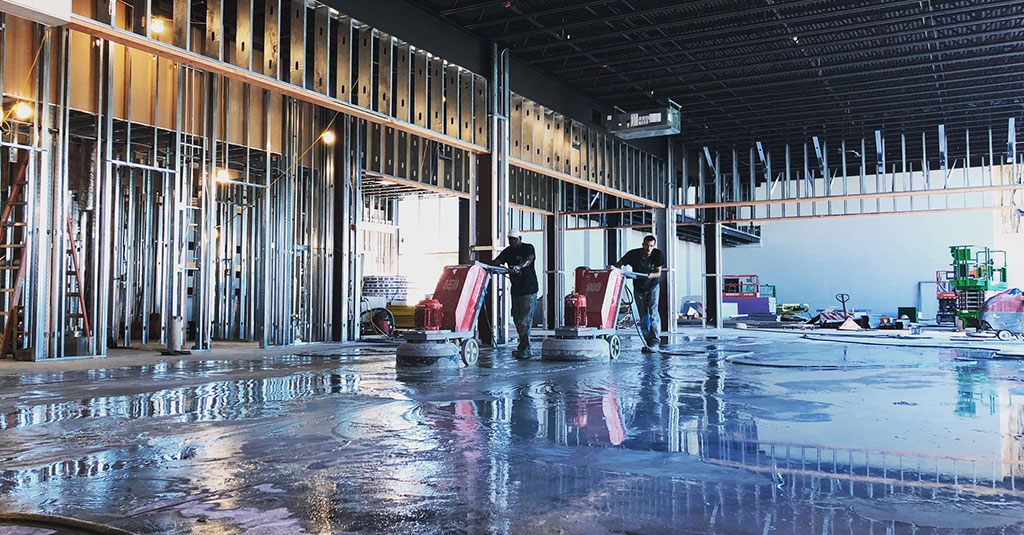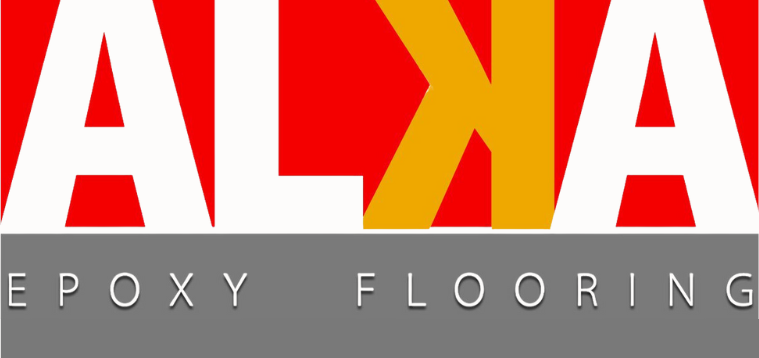Epoxy is a nontoxic chemical substance that has many applications. In the area of construction services, it is used to coat or resurface industrial and residential floors, known as epoxy flooring. The actual purpose of utilizing epoxy is to protect the ground against possible threats in a specific period. The professional implication of this material to any ground can guarantee incident and accident-free circumstances for your floor. Epoxy provides a tough, protective coating with excellent hardness. Plus, epoxy coatings are formulated as an emulsion in water and can be cleaned up without solvents.
Epoxy floor coating is a type of synthetic resin floor system that is laid on top of concrete substrates as a form of protection and decoration. The systems can comprise of several layers of thermosetting resin that are coated, troweled or poured, and generally applied onto a concrete substrate.
Epoxy floor painting is suitable for various applications, such as industrial, commercial, residential, and outdoor spaces. Whether you need a floor that can withstand heavy traffic, high temperatures, or harsh conditions, epoxy floor coating can meet your needs. Resin epoxy floor painting can also create a stunning visual effect, adding value and style to your space.

What is Epoxy Flooring and How Does it Work?
Epoxy flooring is a type of floor coating that uses a combination of epoxy resin and hardener to create a durable, smooth, and glossy surface. It can be applied over various types of floors, such as concrete, wood, metal, or tile, to improve their appearance and performance.
Floor epoxy painting works by creating a chemical reaction between the resin and the hardener. The resin is a liquid substance that provides the color and texture of the floor. The hardener is a catalyst that activates the curing process of the resin. When the two components are mixed together, they form a thick paste that can be spread over the floor using a roller, a squeegee, or a trowel. The paste then hardens and bonds with the substrate, forming a seamless and solid layer.
The Different Types of Epoxy Flooring Systems and Where to Use Them
There are different types of epoxy flooring systems that can be used for different purposes and environments. Some of the common types of epoxy floor coating systems are:
Self-Leveling Epoxy Floors
This type of epoxy flooring is used to create a smooth and level surface over a rough or uneven floor. Self-leveling epoxy floors are easy to install and can be customized with different colors and patterns. They are ideal for spaces that require a clean and seamless look, such as manufacturing buildings, warehouses, showrooms, commercial garages, kitchens, and athletic facilities.
Epoxy Mortar Floors
This type of epoxy floor painting is the strongest and most durable among all epoxy systems. It is made of 100% solid epoxies and graded sand or quartz sand. Epoxy mortar floors are highly resistant to chemicals, impact, and abrasion. They can be used to repair cracks and damages on the floor before applying another type of epoxy system. They are suitable for spaces that require a high level of protection and strength, such as mechanical rooms, warehouses, commercial kitchens, restaurants, garages, and manufacturing plants.
Flake Epoxy Floors
This type of epoxy flooring is made of epoxy resin and hardener mixed with colored flakes or chips. The flakes add texture, color, and style to the floor. Flake epoxy floors can also improve the slip resistance and durability of the floor. They are commonly used for decorative purposes in spaces such as schools, hospitals, offices, retail stores, and residential areas.
The Benefits of Epoxy Flooring: Durability, Customization & Sustainability
Epoxy floor coating has many benefits that make it a superior choice for different applications and environments. Some of the benefits of epoxy floor painting are:
Durability
Epoxy flooring is extremely durable and can withstand heavy traffic, high temperatures, and harsh conditions. Epoxy flooring can last for years without cracking, peeling, or fading. It can also protect the underlying floor from damage and wear.
Customization
Epoxy floor coating is highly customizable and can be tailored to suit your preferences and needs. You can choose from a wide range of colors, patterns, textures, and finishes to create a unique and attractive floor. You can also add decorative elements such as flakes, quartz, or metallic pigments to enhance the visual appeal of your floor.
Sustainability
Epoxy flooring is environmentally friendly and can reduce your carbon footprint. Epoxy floor painting is made of low-VOC materials that do not emit harmful fumes or odors. It also reduces the need for harsh cleaners and minimizes waste. Epoxy flooring can also improve the energy efficiency of your space by reflecting light and heat.
What are the Disadvantages of Epoxy Flooring?
Epoxy floor coating is often used in garages, basements, warehouses, and industrial settings because of its resistance to stains, chemicals, and abrasion. However, epoxy floor painting also has some disadvantages that you should be aware of before installing it in your home or business. Here are some of the drawbacks of epoxy flooring:
Resin epoxy flooring can be slippery when wet
Epoxy floor coating has a glossy finish that can make it slippery when exposed to water or oil spills. This can pose a safety hazard for people and vehicles that use the floor, especially in high-traffic areas. To prevent this, you may need to add anti-slip additives or mats to the epoxy floor, which can increase the cost and maintenance of the coating.
Epoxy flooring can be difficult to install and repair
Epoxy floor coating requires careful preparation and application to ensure a smooth and even result. The epoxy resin and hardener have to be mixed in the right proportions and applied quickly before they harden. Any mistakes or imperfections during the installation process can be hard to fix once the epoxy cures. Moreover, epoxy floor painting can crack or chip over time due to heavy impacts or temperature changes. Repairing epoxy resin flooring can be challenging and expensive, as you may need to remove and replace the entire damaged section.
Epoxy flooring can emit toxic fumes
Epoxy floor coating is made of synthetic materials that can release volatile organic compounds (VOCs) during and after the installation process. VOCs are harmful chemicals that can cause irritation to the eyes, nose, throat, and lungs, as well as headaches, nausea, and dizziness. People with asthma or allergies may be more sensitive to these fumes. To avoid exposure to VOCs, you may need to wear protective gear, ventilate the area well, and wait for the epoxy to cure completely before using the floor.
How to Apply Epoxy Flooring: A Step-By-Step Tutorial
Applying epoxy flooring is not a difficult task, but it requires some preparation and attention to detail. Here are the steps to apply epoxy floor coating:
Step 1: Prepare the Floor
The first step is to clean and repair the floor that you want to coat with epoxy. You need to remove any dirt, dust, grease, oil, or stains from the floor using a broom, vacuum, or degreaser. Also you can fill any cracks, holes, or damages on the floor using a concrete patch or filler. You may also need to sand or grind the floor to create a rough and even surface for better adhesion.
Step 2: Prime the Floor
The second step is to apply a primer coat on the floor using a roller or a sprayer. The primer is a thin layer of epoxy that helps seal the floor and improve the bond between the epoxy and the substrate. The primer also helps prevent air bubbles and moisture problems in the epoxy coating. You need to let the primer dry for at least 4 hours before applying the next coat.
Step 3: Coat the Floor
The third step is to mix the epoxy resin and hardener according to the manufacturer’s instructions. You need to use a drill and a paddle mixer to blend the two components well. Also, you need to work fast as the epoxy mixture has a limited pot life (the time it can be used before it hardens). You can use a roller, a squeegee, or a trowel to spread the epoxy mixture over the floor in thin and even layers. You need to cover the entire floor with epoxy and avoid any gaps or overlaps.
Step 4: Finish the Floor
The final step is to add any decorative elements or protective coatings to your epoxy floor. You can sprinkle flakes, quartz, or metallic pigments over the wet epoxy to create a textured and colorful effect. Also you canapply a topcoat or a sealer over the epoxy to enhance its durability, gloss, and resistance. You need to let the epoxy cure for at least 24 hours before walking on it and at least 72 hours before driving on it.
Congratulations! You have successfully applied epoxy flooring to your space. You can enjoy your new and improved floor for years to come. If you need more information about epoxy floor painting DIY, We refer you to our retail division, ALKA Coatings, as a first-rate supplier of quality epoxy in Australia. We will give advice, support, and products you can rely on that not only provide superior protection but also help improve the efficiency of what they do.
Conclusion: Why Epoxy Flooring is the Perfect Choice for Your Project
Epoxy flooring is a type of floor coating that uses a combination of epoxy resin and hardener to create a durable, smooth, and glossy surface. Epoxy floor coating can be applied over various types of floors, such as concrete, wood, metal, or tile, to improve their appearance and performance.
In this article, we have discussed the different types, benefits, and applications of epoxy flooring. We have also shown you how to apply epoxy floor coating in a step-by-step tutorial. We hope you have learned a lot from this article and are ready to start your epoxy floor painting project.
Epoxy flooring is a smart and cost-effective solution for your flooring needs. It can enhance the value and style of your space while providing you with a long-lasting and easy-to-maintain floor. To learn more about epoxy floor coating and how it can transform your space, visit our website or contact us today. We are happy to provide you with a free quote and consultation.
If you want to learn more about epoxy flooring and how it can transform your space, visit our website or contact us today. We as a professional epoxy floor coating contractor in Sydney at ALKA Epoxy Flooring Sydney Services are happy to provide you with a free quote and consultation.
Thank you for reading this article. We hope you enjoyed it and found it useful. Please share it with your friends and family who might be interested in epoxy floor panting. Also, don’t forget to subscribe to our blog for more articles like this one.
